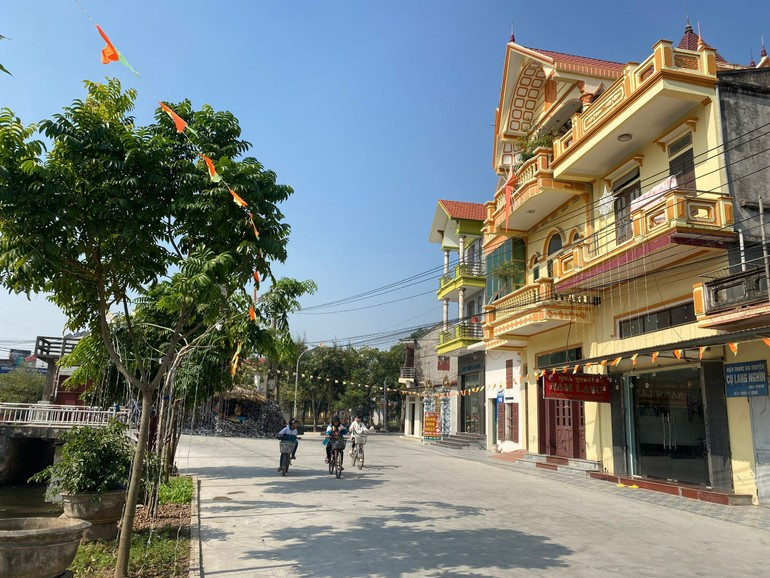
Nam Dinh is one of the first two provinces in the country to complete the New-style rural development programme. (Photo: Ngoc Anh)
After more than a decade of implementation, the National target programme on new-style rural area development has clearly left its mark on the socio-economic life of tens of millions of rural residents.
A key factor behind this success is the efficient and effective mobilisation of resources, ranging from the state budget to contributions from the public, businesses, and social organisations. The 2021–2025 period continues to affirm the crucial role of this work in the face of numerous intertwined challenges
Mobilising collective strength for rural advancement
According to preliminary reports, by the end of May 2025, total resources mobilised for the 2021–2025 phase of the New-style rural area development programme are estimated at 3.7 quadrillion VND (over 141 billion USD). This figure reflects tremendous effort in a context where the state budget remains constrained and the economy has been significantly impacted by the COVID-19 pandemic and global fluctuations.
Of this total, credit sources account for the largest share at 60.8%, highlighting the banking sector’s vital role in channelling capital into rural development. Contributions from businesses and citizens make up 23.1%, illustrating the widespread impact of the movement “The entire country joins hands to build new-style rural areas.” The state budget continues to play a leading and catalytic role, with central funding accounting for 1.1% of total resources (approximately 41.26 trillion VND or 1.57 billion USD). Though modest in proportion, it plays a directional role, triggering further mobilisation of social resources.
For the Sustainable poverty reduction programme, central state budget funding for the 2021–2025 period reached 44.61 trillion VND (1.7 billion USD), with local budgets contributing around 2.88 trillion VND (110 million USD) and over 8.9 trillion VND (339 million USD) mobilised from other sources (through integration and community participation).
Targeted and effective use of funds, avoiding dispersion
Beyond scale, a highlight of this phase is the focused and strategic use of resources, aligned with practical needs and long-term vision.
According to statistics, the disbursement rate of central budget capital for the New-style rural area development programme during 2021–2024 period reached about 80.6%, while the Sustainable poverty reduction programme reached nearly 79%. These are relatively strong outcomes given the challenges localities faced from weather fluctuations, market volatility, and institutional reforms.
Budget capital has been prioritised for essential projects: rural roads, irrigation, electricity, healthcare, education, and environmental protection. Nearly 90,000 poor and near-poor households have received support for sustainable housing; more than 4,966 works in poor districts and specially disadvantaged communes have been constructed or renovated, helping comprehensively improve rural infrastructure.
Meanwhile, credit capital has mainly been directed towards production, start-ups, OCOP, and rural tourism development. More than 10,500 livelihood models have been deployed, and tens of thousands of households supported in career transition and high-tech agricultural production
People at the centre and as the driving force of development
A prominent feature that sets the New-style rural area development programme apart is its approach: people are not just beneficiaries, but also the main stakeholders and investors.
In the 2021–2025 period alone, people nationwide have voluntarily donated over 98.2 million m² of land, contributed trillions of VND, and millions of workdays to build roads, cultural houses, schools, irrigation works, and more.
This not only reduces pressure on the state budget but also strengthens community cohesion and generates long-term development value. In many localities, people have actively mobilised social resources, connecting with businesses and philanthropists to invest in model initiatives, community tourism, and OCOP products.
Valuable lessons and practical experience
From actual implementation, five key lessons on resource mobilisation and utilisation in building new-style rural areas can be drawn: The state plays a guiding role, especially in initial investment, but must accompany this with mechanisms that encourage participation from people, businesses, and international organisations. Strong decentralisation must be paired with autonomy and accountability.
Flexibility in using capital helps reduce waste and improve efficiency. Instead of chasing numbers, the focus should be on quality and sustainability, especially maintaining and enhancing criteria once achieved. Effective integration of other programmes and projects helps avoid dispersion and fragmentation of resources. Transparency and strict monitoring in the allocation and use of funds must be ensured, with enhanced inspections, post-evaluation, and social oversight.
Towards the 2026–2035 period: Targeted investment, green growth, and digital transformation
In the direction for the next period, resource mobilisation and utilisation will remain decisive. To meet the targets: By 2030, 80% of communes are to meet new-style rural standards, and rural residents’ average income will increase by at least 2.5 times. By 2035, 90% of communes will meet the standards, with 25% reaching advanced modern levels.
Key solutions include: establishing flexible financial mechanisms allowing localities autonomy in fund allocation, expanding commune-level authority over land revenue. Enhancing public–private partnerships, attracting ODA and international grants, developing dedicated credit mechanisms for OCOP, rural tourism, environment, and clean water.
Applying digital transformation in capital management and investment monitoring, gradually digitising all project and construction data for rural development. Investment areas should be grouped by peri-urban, disadvantaged, and intermediate zones, avoiding rigid, uniform models
Building new-style rural areas is a long-term journey that cannot rely solely on the state budget.
The success of the 2021–2025 phase has shown that: diversified resource mobilisation, targeted investment, and empowering people as key actors are the “golden keys” to unlocking modern, comprehensive, and sustainable rural development.
In the next phase, along with green and digital transitions, localities must continue to innovate in accessing resources, clearly identify investment priorities, and above all, place trust in the people—the centre of all rural development policies.